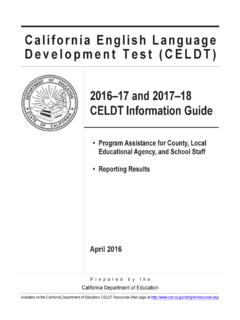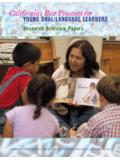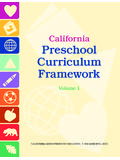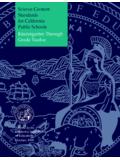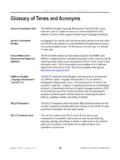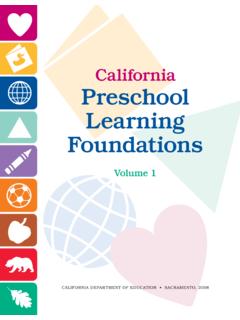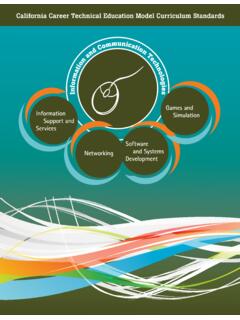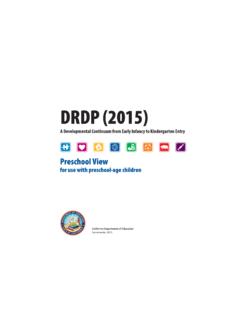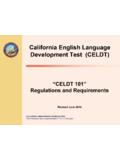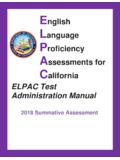Transcription of N I A O R Questions — Updated - cde.ca.gov
1 california english language development Test ( celdt )STATEOFCALIFORNIADEPARTMENTOFEDUC ATIONR eleased Test Questions UpdatedSeptember 2012 Prepared by theCalifornia Department of EducationAvailable on the california Department of Education celdt Resources Web page at 2012 by the california Department of Education (CDE). All rights reserved. This document may be copied and distributed by individuals and by california local educational agencies. This document and its contents may not be edited or altered, and must remain unchanged as published by the CDE. Any other use or reproduction of this document, in whole or in part, requires written permission from the l i f o r n i a En g l i s h la n g u a gE DEvEl o p mEn t tEs tiCalifornia Department of Education n September 2012 Released Test Questions UpdatedCELDT Released Test Questions UpdatedTable of ContentsIntroduction.
2 1 Released Test QuestionsOverview ..3 Test Components by Domain ..6 Released Test Questions by Grade and DomainKindergarten and Grade One (Reading and Writing) ..8 Kindergarten Through Grade Two (Listening and Speaking) ..15 Grade Two (Reading and Writing) ..23 Grades Three Through Five (Listening, Speaking, Reading, and Writing) ..33 Grades Six Through Eight (Listening, Speaking, Reading, and Writing) ..50 Grades Nine Through Twelve (Listening, Speaking, Reading, and Writing) ..68 AppendixesAppendix A: Scoring RubricsKindergarten and Grade One ReadingWord Analysis ..87 Kindergarten and Grade One WritingCopying Letters ..88 Copying Words ..88 Write the Word (Picture Prompt) ..88 Write a Word (Story Prompt) ..89 Kindergarten Through Grade Twelve SpeakingChoose and Give 904-Picture Narrative ..91 Speech Functions ..93 Grades Two Through Twelve 94 Short Compositions ..96 Appendix B: Overall Test Performance Descriptors.
3 99Ca l i f o r n i a En g l i s h la n g u a gE DEvEl o p mEn t tEs t1 california Department of Education n September 2012 Released Test Questions UpdatedIntroductionState law ( california Education Code sections 313 and 60810) and federal law (Title III of the Elementary and Secondary Education Act [ESEA]) require that local educational agencies (LEAs) administer an initial assessment (IA) of english language proficiency to newly enrolled students whose primary language is not english and an annual assessment (AA) to students who have been previously identified as english learners (ELs). For california s public school students, this test is the california english language development Test ( celdt ).The celdt has three purposes:n To identify students who are limited english proficient (LEP)n To determine the level of english language proficiency of LEP studentsn To assess the progress of LEP students in acquiring the skills of Listening, Speaking, Reading, and Writing in english The purpose of this document is to provide celdt question samples ( , released test Questions or RTQs) for site and LEA administrators, teachers, and parents or guardians.
4 These Questions cover the four domains assessed by the celdt : Listening, Speaking, Reading, and Writing. This Updated document, which reflects minor revisions in the scoring rubrics for writing, and a glossary are available on the california Department of Education (CDE) celdt Resources Web page at l i f o r n i a En g l i s h la n g u a gE DEvEl o p mEn t tEs t2 california Department of Education n September 2012 Released Test Questions UpdatedReleased Test QuestionsOverviewTest Components by DomainReleased Test Questions by Grade and DomainKindergarten and Grade One (Reading and Writing) Kindergarten Through Grade Two (Listening and Speaking)Grade Two (Reading and Writing) Grades Three Through Five (Listening, Speaking, Reading, and Writing)Grades Six Through Eight (Listening, Speaking, Reading, and Writing)Grades Nine Through Twelve (Listening, Speaking, Reading, and Writing)
5 Ca l i f o r n i a En g l i s h la n g u a gE DEvEl o p mEn t tEs t3 california Department of Education n September 2012 Released Test Questions UpdatedOverviewThis document contains 80 test Questions from celdt administrations, ranging from 2003 04 through 2009 10. The Questions are organized by grade and cover the four domains assessed by the celdt : Listening, Speaking, Reading, and Writing. Each question includes the english language development (ELD) standard addressed, the test component, the scoring method used, and information on student performance. Graphics for the Questions have been reduced to fit onto the and Grade OneThe test for kindergarten and grade one (K 1) students in Reading and Writing began with the 2009 10 celdt Edition. The 13 K 1 Reading and Writing Questions in this document are sample practice Questions for the different test components.
6 Because practice Questions are not scored, they do not include information on student performance. Questions for Listening and Speaking in K 1, which are the same as Listening and Speaking Questions given in grade two, are located in the kindergarten through grade two (K 2) section on pages 15 through DevelopmentAll Questions on the celdt address the ELD standards approved by the State Board of Education (SBE) in 1999. These standards define what ELs in california s public schools are expected to know and be able to do as they progress toward english language proficiency. Written by trained educators, celdt Questions go through a quality review process to ensure alignment to the ELD standards and content appropriateness. After field testing, Questions that meet a rigorous set of statistical criteria may be selected for a future operational test form. The complete english - language development Standards for california Public Schools document is available on the CDE Administrative Forms and Documents Web page at Components by DomainWithin each domain, there are several test components.
7 The way each question is administered varies depending on the test component addressed. For example, Questions could be presented orally or in writing, and responses by the student could be presented orally or in writing as well. The Test Components by Domain chart on pages 6 and 7 describes the types of Questions asked and how students are expected to l i f o r n i a En g l i s h la n g u a gE DEvEl o p mEn t tEs t4 california Department of Education n September 2012 Released Test Questions UpdatedStudent PerformanceStatistics provided with each question show how students scored at each performance level on a specific celdt administration. Multiple-choice Questions are scored as 0 for Incorrect or 1 for Correct. Short-response Questions also are scored as 0 for No Response or Incorrect, or 1 for Correct.
8 Both No Response and Incorrect are scored as 0. Other types of Questions in the celdt are scored based on a rubric. Scoring rubrics are used to assign a score to a student s oral or written responses, using a range of score points. Sample student responses are provided for Questions requiring longer oral responses and written sentences or paragraphs. Table 1 provides an example of students overall performance at the statewide level on a multiple-choice question. Table 2 provides an example of students overall performance at the statewide level on a 4-Picture Narrative question that was evaluated with a scoring Performance: Table 1 (Multiple-choice Questions )Overall Performance Level on the celdt % Scored Correctly Beginning65 Early Intermediate 84 Intermediate 91 Early Advanced95 Advanced96 The column on the left refers to the students overall performance levels on the celdt . The celdt results are reported according to five levels: Beginning, Early Intermediate, Intermediate, Early Advanced, and Advanced.
9 The column on the right refers to the percentage of students who answered the question correctly at each overall performance level. In this example, 65 percent of the students scoring at the Beginning level answered the question correctly, suggesting that the test question was somewhat challenging for that group. In contrast, 96 percent of the students who performed at the Advanced level answered the question correctly. During the development of the 2012 13 Edition, the rubrics underwent minor revisions aimed at refining the scoring process and providing more distinction between score points. The revisions should not significantly change students scores; therefore, the overall student performance provided for earlier celdt editions is still l i f o r n i a En g l i s h la n g u a gE DEvEl o p mEn t tEs t5 california Department of Education n September 2012 Released Test Questions UpdatedStudent Performance: Table 2 (4-Picture Narrative question)Average Score Overall Performance Level on the CELDTB ased on Rubric Intermediate 2 shows the average score for a 4-Picture Narrative question that was scored with a scoring rubric ranging from 0 4 score points.
10 For this question, students scoring at the Beginning level had an average score very close to zero (no response or not intelligible). Advanced students scored between 3 and 4 on the scoring rubric, responding with a developed vocabulary and very minor errors that did not affect the meaning. Scoring RubricsConstructed-response Questions for the celdt are scored using a scoring rubric. Scores on those Questions could vary as follows: 0 1 Points: Copying Letters (K 1)0 2 Points: Copying Words, Write the Word, and Write a Word (K 1), Choose and Give Reasons (K 12), and Speech Functions (K 12)0 3 Points: Word Analysis (K 1) and Sentences (2 12)0 4 Points: 4-Picture Narrative (K 12) and Short Compositions (2 12)All the celdt scoring rubrics are available in Appendix A. Multiple-choice Questions (scored as Incorrect or Correct) and short-response Questions (scored as No Response, Incorrect, or Correct) do not have scoring Test Performance DescriptorsOverall test performance descriptors, which are available in Appendix B, describe the competencies associated with each performance level.
